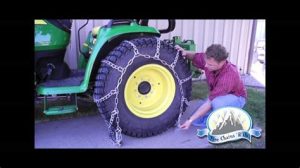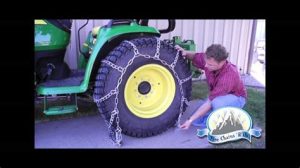Learn how to choose the right chains, measure tire size, install correctly, ensure proper tension, and maintain them for optimal performance.Installing chains on tractor tires can significantly enhance traction and safety, especially in challenging winter conditions or on muddy terrain. However, the process requires careful consideration and proper technique to ensure effectiveness and avoid damage to both the tires and the chains. In this blog post, we will explore the best practices for installing chains on tractor tires, covering essential steps such as choosing the right type of chains, measuring tire size and tread accurately, employing proper installation techniques, ensuring the correct tension, and performing regular maintenance and inspections. Whether you’re a seasoned farmer or a novice in tractor care, following these guidelines will help you maximize the performance of your equipment while keeping safety as a top priority. Let’s dive into the details to ensure your chains are installed correctly and ready for the task ahead!
Choosing the Right Type of Chains
When it comes to selecting the right type of chains for your tractor tires, there are several factors to consider to ensure optimal performance and safety. Chains are designed to improve traction, enhance stability, and protect the tires from wear and tear under various conditions. Here’s a guide to help you choose the best chains for your needs.
1. Type of Chain: There are different types of chains available, including ladder chains, diamond chains, and cable chains. Each type has its advantages and is suited for various applications. Ladder chains are ideal for mobility over snow and ice, while diamond chains provide better traction in muddy or slippery conditions. Cable chains are lighter and easier to install, making them suitable for occasional use.
2. Tire Size: Before purchasing chains, it is crucial to know your tire size. Chains are available in specific sizes, and using the wrong size can lead to ineffective performance or damage. Always refer to the manufacturer’s specifications and choose chains that precisely match your tire dimensions.
3. Material: Chains are typically made from steel, but the quality can vary. Look for chains with higher tensile strength and corrosion-resistant coatings for durability. Additionally, some chains come with added features such as ice cleats or additional links for enhanced grip.
4. Usage Conditions: Consider the environments in which you’ll be operating the tractor most frequently. If you work in extremely icy or hilly areas, investing in heavy-duty chains may be necessary. Conversely, lighter duty chains could suffice for flat, snow-covered surfaces.
Ultimately, choosing the appropriate type of chains involves assessing your unique needs and application scenarios.
Measuring the Tire Size and Tread
When it comes to installing chains on tractor tires, accurately measuring the tire size and tread is crucial for ensuring a proper fit and optimal performance. Knowing your tire specifications helps you select the right size chains, which in turn enhances traction and stability during operations.
The first step in this process is to measure the tire size. Most tires have their sizes marked on the sidewall, typically in the format of Width/Aspect Ratio/Rim Diameter. For example, a tire listings such as 14.9-28 indicates a width of 14.9 inches and a rim diameter of 28 inches. If you’re unsure, you can use a tape measure to confirm these dimensions.
After determining the tire size, it’s important to evaluate the tread depth. This can be done using a simple ruler or a tread depth gauge. Measure from the base of the tread to the top of the tread blocks in several spots around the tire to ensure even wear. Proper tread depth is essential not only for chain fit but also for the overall performance of the tires in various conditions.
Finally, keep in mind that tire wear can affect compatibility with chains. If the treads are significantly worn, you may need to consider replacing the tires to ensure both safety and effectiveness when using tire chains.
Proper Installation Technique and Tools
Installing chains on tractor tires is crucial for enhancing grip and performance, especially in challenging weather conditions. To ensure optimal performance, it’s essential to follow proper installation techniques and use the right tools. Here are the best practices for installing chains effectively.
Before starting the installation, gather the necessary tools.
- Chain Tensioners – To keep the chains tight during use.
- Measuring Tape – To measure tire size accurately.
- Gloves – To protect your hands while handling the chains.
- Hook Tool – For connecting the chain links easily.
- Prepare the area: Ensure that the tractor is on level ground.
- Lay the chains out: Spread the chains on the ground to avoid tangles.
- Position the chain: Wrap the chains around the tire, starting from the top and adjusting for proper fit.
- Connect the hooks: Use the hook tool to secure the chain links together.
- Adjust and tighten: Utilize the chain tensioners to ensure the chains fit snugly against the tire.
Ensuring Proper Tension and Tightening
One of the critical factors in the successful installation of chains on tractor tires is ensuring proper tension and tightening. If the chains are too loose, they can shift during operation, potentially damaging the tires or causing loss of traction. Conversely, chains that are too tight can lead to unnecessary wear and tear on both the chains and the tires.
To start, after installing the chains, it’s essential to drive a short distance and then stop to recheck the tension. This allows any slack that may have appeared during the initial installation to be taken up. Ideally, the chains should fit snugly against the tire without any excessive movement. Utilize a tensioning tool if available, or hand-tighten the individual links to improve fit and securing methods. Each link should align properly to avoid misalignment while the tractor is in use.
When adjusting the chains, pay attention to the side chains as well as the cross links, ensuring uniform tension across all components. It is also advisable to regularly check the chains during operation, especially after hitting bumps or uneven terrain. This practice not only promotes safety but also helps in prolonging the life of both the chains and the tires.
Regular Maintenance and Inspection
Regular maintenance and inspection of your tractor tire chains are crucial for ensuring optimal performance and longevity. Periodically checking the chains helps prevent any potential issues that could lead to unsafe driving conditions. Start by examining the chains for any signs of wear, corrosion, or damage. This practice not only preserves the integrity of the chains but also enhances the safety of operation.
Additionally, it is recommended to keep a maintenance log, documenting each inspection’s findings and any necessary repairs or adjustments made. This record will help track the condition of your chains over time and serve as a reference for future maintenance schedules.
Don’t forget to inspect the tread of your tires as well, as the condition of the tires can affect how well the chains perform.
Frequently Asked Questions
Why is it important to install chains on tractor tires?
Installing chains on tractor tires is crucial for improving traction in icy and snowy conditions, allowing for safer operation and better performance in harsh weather.
What tools do I need to install chains on tractor tires?
You typically need tire chains, a safety chain, and basic tools such as pliers and a wrench for adjustments. It’s also beneficial to have gloves for safety.
How do I determine the correct size of chains for my tractor tires?
To determine the correct size, check the tire specifications on the sidewall of your tires and match them with the size listed for the tire chains available.
What are the steps to properly install chains on tractor tires?
First, park the tractor on a flat surface and ensure the tires are clean. Then, lay the chains flat next to the tires, and drape them over the top, adjusting them evenly. Finally, secure and tighten the chains according to the manufacturer’s instructions.
Should I install chains on all four tires of the tractor?
It is generally advisable to install chains on all four tires for optimal traction, especially if conditions are particularly challenging, but it may depend on your specific use and tractor configuration.
How can I maintain tire chains after installation?
Regularly inspect the chains for wear and tear, ensure they remain tight during use, clean them of any debris or rust, and store them properly when not in use to prolong their lifespan.
Are there any safety precautions I should take while installing tire chains?
Yes, always wear gloves to protect your hands, ensure the tractor is turned off, and avoid working under the tractor to prevent any accidents. Additionally, be cautious of pinching or caught fingers during installation.





